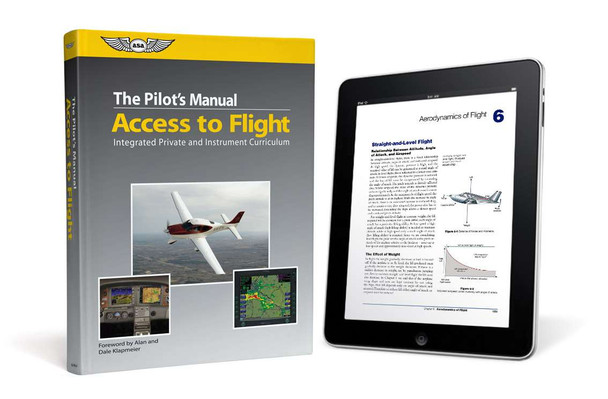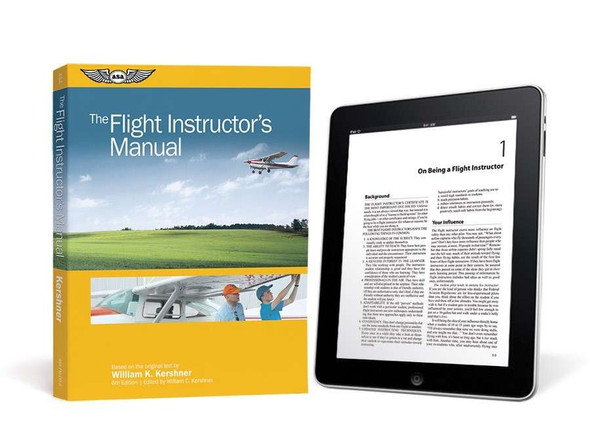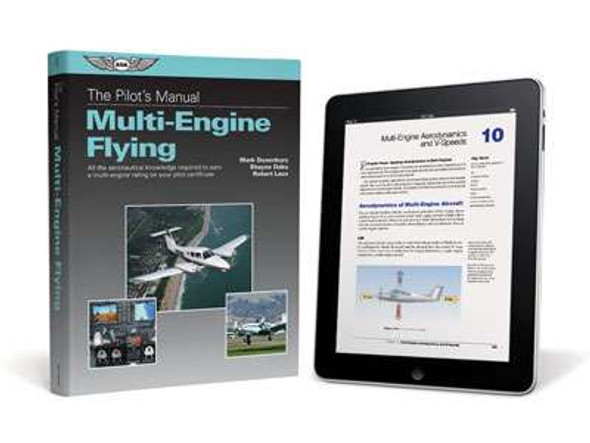Description
| Author | Aviation Theory Centre & |
| Paul Craig | |
| ISBNs | 978-1-56027-734-7 |
| 978-1-56027-836-8 |
This money-saving eBundle includes both the Hardcover Book andASA eBook PDF (available for immediate download).
Notes on Compatibility:
- The ASA eBook included in this eBundle requires Adobe® Digital Editions, which is available as a FREE Download, to be installed on your desktop or laptop computer.
- Adobe Digital Editions is NOTyet fully supported on Mac OSX Lion, however, Adobe has a Beta version available that may work for you. Click HEREfor more information.
- ASA eBooks can be installed on up to 5 devices simultaneously, and read on a range of digital devices including the Apple iPhone®, iPad®, iPod Touch®, and Android® smartphones/tablets as well as PC and Mac computers.
| ✈ How do I get my eBooks onto my Android ?
To view eBooks on a mobile device like an Android based tablet or phone, follow the steps below:
|
| ✈ How do I get my eBooks onto my iPhone, iPad, or iPod Touch ?
To view eBooks on a mobile device like an iPad, iPhone or iPod Touch, follow the steps below:
|
Meeting the challenges of training in the 21st century!
Important FAA rule change released 8/31/2011 allows for a combined Private Pilot and Instrument Rating Course/Checkride. It's a revolutionary way to train!
Whether you fly for pleasure, business, or a career in aviation, the Private Pilot certificate with the Instrument Rating is your ticket into the full spectrum of the airspace system — it is the key to maximizing the utility of a general aviation aircraft. This book provides the information you need to learn how to fly under both visual flight rules (VFR) and instrument flight rules (IFR). The most comprehensive pilot textbook available, The Pilot's Manual: Access to Flight provides efficient training methodology that helps you graduate with a truly successful personal transportation solution.
Technically Advanced Aircraft (TAA) demand a level of understanding and functional proficiency as never before. This breakthrough course is simply the most efficient and comprehensive way to prepare for flight in TAA and today’s increasingly complex flight environment. In addition, chapter review questions will help prepare you for the FAA Private and Instrument Knowledge Tests.
General aviation has undergone an extraordinary transformation in recent years. EFIS (electronic flight instrument system) or “glass” cockpit-equipped aircraft, once the exclusive realm of airline, corporate, and military pilots, have now proliferated the GA landscape. In what seemed like the blink of an eye, pilots and instructors accustomed to flying aircraft equipped with conventional gauges that hadn’t changed much in almost 50 years were now sitting behind sophisticated systems with glowing displays, comparable only to some of the most advanced airliners and corporate jets. These second generation “Technically Advanced Aircraft” (TAA) literally represented the coming of a new age and the promise of nearly unlimited potential. At the same time however, the arrival of these sophisticated aircraft created an unprecedented training and operational challenge never experienced in GA. The Pilot's Manual: Access to Flight has been specifically crafted to meet this challenge, making use of methods that will allow pilots to obtain the maximum safety and utility from their aircraft.
For the first time ever, Private and Instrument curriculums are integrated so pilots flying TAA learn to intrinsically manage the combined skills of aircraft control, task management, systems management, and the complex flight environment of today’s busy airspace. This is a very different approach from the practice of traditional maneuver-based flight training used heretofore. With a realization of the inadequacy of maneuver-based training as applied to TAA, The Pilot's Manual: Access to Flight embodies the state-of-the-art industry training standards of scenario-based training (SBT), learner centered grading and involvement, and single pilot resource management (SRM). These are real world skills, taught with a train-like-you-fly, fly-like-you-train philosophy, treating each and every lesson as a "real" flight. This is where harnessing the power of all available resources and aeronautical decision making (ADM) become second nature. Whereas maneuver-based training focused specifically on simply learning to control the aircraft, this new methodology involves considering an entire flight, and all its component aspects, from beginning to end.
ALSO AVAILABLE AS A BOOK!
Product Reviews
Shipping & Returns
Shipping (USA)
Shipping is available via UPS or USPS and most items ship within 24 hours if the order is placed between Sunday and Thursday. Orders placed after 11am EST for USPS and after 2pm EST for UPS my not ship the same day. If your order comes in prior to that Monday through Friday, we try to get it out same day. All USPS shipments are picked up by Noon Monday through Friday. All UPS shipments are picked up by 3pm EST (sometimes earlier) Monday through Friday.
Any date estimates on shipping are provided by the shipping companies and do not include processing time, please be advised of that when making your shipping decisions. Their estimates do not factor in weekends, holidays, or processing time.
If you are local to SkySupplyUSA (New Castle, PA - about an hour north of Pittsburgh and an hour south-east of Cleveland), please feel free to stop in during our business hours Monday - Friday 8:30am - 5pm EST. If you know exactly what item you're looking for, give us a call and we'll have your items pulled at the front counter!
We can also ship with your FedEx or UPS account number, please call us for more information on those options.
Please also note that the shipping rates for all items we sell are weight-based. To reflect the policies of the shipping companies we use, all weights will be rounded up to the next full pound. We realize this sometimes causes inflated shipping rates when ordering a large quantity of items, so if you feel that the estimator is giving you an outrageous shipping quote, feel free to reach out and we can double check.
Expedited Shipping (UPS Next Day, 2nd Day, or 3 Day)
Orders placed after 2 PM EST will be shipped the next business day.
UPS does not pick up on Saturday or Sunday, so all weekend orders will ship on Monday.
International Shipping
We can ship to almost any destination in the world. International customers must understand that all packages are shipped after a (3) day Review period and must clear customs in your country. The amount of time to do so varies from country to country and we have no control of the package during that time.
Customs, Duties, and Taxes (International)
You are responsible for assuring that the product can be lawfully imported to the destination country. When ordering from SkySupplyUSA, the recipient is the importer of record and must comply with all laws and regulations of the destination country. Orders that are shipped to countries outside of the United States may be subject to import taxes, customs duties and fees levied by the destination country. The recipient of an international shipment may be subject to such import taxes, customs duties and fees, which are levied once a shipment reaches your country. Additional charges for customs clearance must be borne by the recipient; we have no control over these charges and cannot predict what they may be. Customs policies vary widely from country to country; you should contact your local customs office for further information. When customs clearance procedures are required, it can cause delays beyond our original delivery estimates.
Returns Policy
You must call or email for an RMA number. No refunds on unauthorized returns.
We offer a 30 day return period. Returned items must be in "brand new" condition and in its undamaged original packaging to be eligible for return. Spark plugs must be in their sealed plastic sleeves. Opened sleeved spark plugs are not returnable. There will be a 20% - 40% restocking fee on all non-defective products. The restocking fee varies from product to product. Special order items are not returnable.
You must pay the return shipping costs. If the return is a result of our error (you received an incorrect or defective item, etc.), we will refund it once the item has been returned in new condition and the issue is verified. Please note that computer software that has been opened or activated cannot be returned. Defective software will be replaced with the same product as purchased. All shipping charges will be paid by the buyer.
Refunds cannot be guaranteed for non-trackable shipping.
You should expect to receive your refund within four weeks of giving your package to the return shipper, however, in many cases you will receive a refund more quickly. This time period includes the transit time for us to receive your return from the shipper (5 to 10 business days), the time it takes us to process your return once we receive it (3 to 5 business days), and the time it takes your bank to process our refund request (5 to 10 business days).
If your item includes a manufacturers return policy that differs from SkySupplyUSA policies, you will need to contact them directly to resolve your issue.







